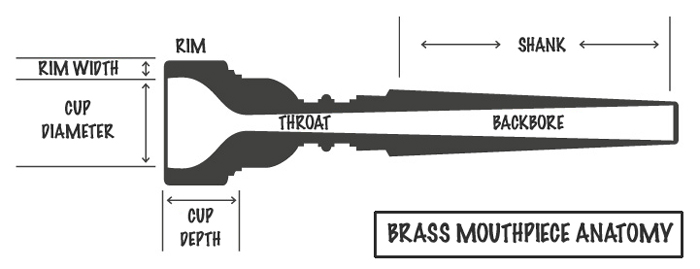Brass Mouthpieces – An Overview
30th October 2018Why so Important?
All brass players wonder at one time or another whether or not making a change to their mouthpiece will help. Could it give them more range, more volume or a bigger sound? A change in the mouthpiece can yield fantastic results to the player. You can achieve faster, higher and louder from just a small change.
The mouthpiece is the part of the instrument that communicates the sounds and expressions from you to the instrument. Even the smallest change can alter your whole sound.
If you play a brass instrument, choosing a mouthpiece can appear to be a minefield as there are now so many manufacturers. Major brands such as Denis Wick, Vincent Bach, Yamaha and Schilke all make an excellent range of brass mouthpieces. They produce mouthpieces in an abundance of size options. There are also extra choices to make sometimes between heavy top or standard, wide rim or narrow, barrel or V-shape… you get the idea! However, there are some basic brass mouthpiece anatomy facts to know that we have listed below:
Golden rules
- Mouthpiece cup diameter: increasing this will make more of your lips vibrate inside the cup and give a richer sound. However, it may also compromise endurance and stamina. Players will often progress onto wider cups as their embouchure grows stronger.
- Cup depth: a deeper cup gives a fuller sound but makes playing higher more difficult. Shallower cups make high playing much easier but will produce a harsher tone. Some players choose these ‘fast-track’ options but always have to consider the inherent compromises.
- Rim width/ sharpness: a wide rim will make playing for long periods of time very comfortable but will make lip slurring harder. A thinner, sharper rim will vastly improve lip slurring and flexibility. However, it can become very uncomfortable for endurance playing.
- Backbore: this is possibly the most complicated measurement. A wider backbore will make the whole instrument feel and play more openly but this will affect your breathing and endurance. A narrow backbore increases resistance, which can make higher notes easier to hit but gives a very thin sound. It’s best to consider this as part of the wider set of measurements. It’s not something to worry about until the very advanced stages.
- Outer design: this is not just about how the mouthpiece looks, but the distribution of weight around the outside of the cup can have a big impact on the response of the instrument. Adding weight towards the bottom of the cup gives a more focused, intense sound. However, it also reduces the feedback given to you by the instrument. Traditional shaped mouthpieces have a brighter sound and may not carry as far, but can help increase flexibility.
Try on Approval
We tend to keep the most popular makes and sizes in stock for all instruments so we are certain to be able to help you find something to suit you. All of our mouthpieces can be tested in store or via mail order, and once you have chosen, we encourage you to take advantage of our 2 week home approval so the mouthpiece can be tested “in situ” at band or with your teacher. We charge a £3.00 “hygiene” fee to cover the cost of cleaning the mouthpiece should you decide to return it.
We offer a range of Trumpet Mouthpieces, Cornet Mouthpieces, Tenor Horn Mouthpieces, Baritone Horn Mouthpieces, Trombone Mouthpieces and Tuba Mouthpieces.
Not Sure Where to Start?
Why not contact us for some advice. We can help point you in the direction whether you are the parent of an advancing child or if you are an experienced professional. Our award-winning team can help you find the right mouthpiece.
